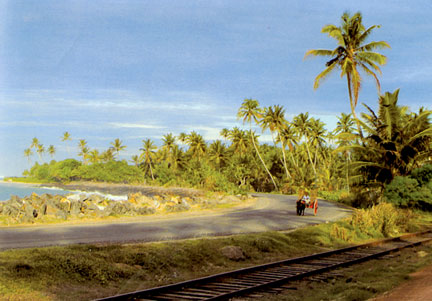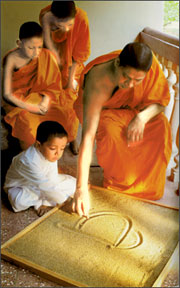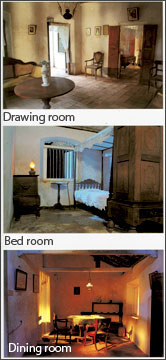Story behind the story
From the Cradle
Glimpses of Sri Lankan Folk Culture
portrayed at the Martin Wickramasinghe Museum of Folk Culture
Photography:Sarath Perera
Design and Layout: Somachandra Peiris
Text: D.C Ranatunga
by Aditha Dissanayake
[email protected]
|

The railroad extending as far as the eye could see |
Girls hardly ever tie their hair with ribbons these days. But the
metaphor of the black ribbon lives on. Whoever travels on the Galle
Matara road will constantly remember the comparison of the smooth black
ribbon to the long stretch of tar in Gamperaliya. Like the book the
metaphor too has become immortal.
But Koggala? The village in the mid south situated between a creek
and the sea. The village with the rail track like a never ending
stepladder, stretching as far as the eye could see? With its numerous
tourist restaurants and garment factories the Koggala of today is a far
cry from the Koggala Martin Wickramasinghe describes in Gamperaliya.
Now, though, thanks to the book published by the Martin
Wickramasinghe Trust, called "From the Cradle: Glimpses of Sri Lankan
Folk Culture", the world described in Gamperaliya too will be
immortalized.
|

Writing on the ‘veli-pila’
 |
According to the publishers the 118 page A4 size book with texts by
D.C Ranatunga, photographs by Sarath Perera and layout by Somachandra
Peiris is intended to kindle an interest in the cultural heritage of Sri
Lanka and Martin Wickramasinghe's writings among the present generation
and the generations to come.
"My body grew like that of any Sinhala villager. My mind however
developed differently. The benefit of a private education from a centre
of higher learning or from learned pundits was not available to me. I
resorted to learning by directly exploring my world, and by eagerly
reading books".
Wrote Martin Wickramasinghe, The only son of Lamahewage Don Bastian
Wickramasinghe and Magalle Balapitiya Liyanage Thochchohamy, Martin
Wickramasinghe was born on 29th May 1891. The financial circumstances
which had made him become the sole breadwinner in a family of nine
sisters and a widowed mother, at the age of fourteen was perhaps a
blessing in disguise, for this prevented him from being shackled to a
limited field of study endorsed by institutes of higher education.
He was free to roam the fields of knowledge without being restricted
by academic boundaries. And roam the fields he did, physically, in his
childhood in the village of Koggala, gathering experiences which would
later form the basis of such books as Madol Doova, Gamperaliya, Ape Gama...
It is this world that the text and the ample illustrations in "From
the Cradle" present to the reader, often quoting from Dr. Lakshmi de
Silva's "Lay Bare the Roots". Here is how the fascination with the
village craftsman is described " Of all the instruments in the
carpenter's shed what interested us most was the lathe.
We watched chair legs of beds and cupboards,or carved pillars take
shape under the lathe, and sometimes returned home only after the
carpenter had ceased work. The book also gives an attractive description
of the "Thrills on the Water" re-creating the background for Upali's
trip as a stowaway in "Madol Doova.
"The sea was a battlefield. Balaya were even banging against the
sides of the boat. They fought for the bait like a pack of dogs for
bones or like bats around a fruit tree...I have never participated in
anything so fascinating or so exciting since. I think the fishermen too
loved the thrill of it more than a gambler loves his game".
Talking about his childhood Dr. Ranga Wickramasinghe says "It was
very difficult to feed and educate six children with what my father
earned from working at the Lake House and through the sale of his books.
My mother was a very simple person and I know both my parents
sacrificed a lot to bring us up. Whenever we did well in school my
father took us to M.D Gunasena's and asked us to choose any book we
liked. I grew up reading Coral Island but I am happy that my children
and grandchildren grew up reading 'Madol Doova".
Creative writing was not his only forte. In fact everything under the
sun seemed to have come under Martin Wickramasinghe's scrutiny. The
subjects Martin Wickramasinghe explored ranged from anthropology, to
biology, from social sciences to Buddhism, from philosophy to fine arts.
He wrote 14 novels beginning with Leela in 1914 and ending with
Bawatharanaya (Siddhartha's Quest) in 1975. Gamperaliya (The uprooted)
was published in 1944, followed by Madolduwa (Mangrove Island) in 1947,
Yuganthaya (End of an Era)in 1949, Viragaya (Devoid of Passion) 1956,
and Kaliyugaya (Age of Destruction)1957. Among his eleven collections of
short stories are Gehaniyak (A woman), 1924 and Ape Viththi (About
Ourselves)1946.
He also wrote four dramas Chitra, (1940)Mayuri (1944), Vijitha (1953)
and Vijitha and Other Plays 1953 as well as on travel, history, three
literary biographies, six books on philosophy and other topics, five on
evolution and anthropology, and numerous essays of literary criticism.
Several of his novels were made into films and teledramas.
Using the idiom of common speech in place of the heavy classical
language found in Pali and Sanskrit literature he opened the doors of
Western science to Sinhala readers; explained the idea of evolution and
showed the relationship between Buddhism and modern scientific
discoveries about the nature of the physical world.
He wrote the first book on the social history of Sri Lanka - Purana
Sthreenge Anduma, and the first science fiction book for children,
Sinhala Vidya Vinoda Katha". He worked as a journalist for over twenty
years as the editor of Dinamina, Silumina and Lakmina.
He was also a critic, and would go down in literary history as the
one who changed the basis of Sinhala literary criticism which had
hitherto been modeled on Pali and Sanskrit literature by introducing a
more rationale view in judging works of art.
He had his own private library. All in all he had had over 7,000
books, all of which he had read and written comments on, in the margins.
Whenever he had disagreed with what the writer had written, he dismissed
the paragraph by writing on the margin bahubootha (rubbish).
"The library with its different coloured books of varying sizes was
like one huge map to me when I was small" recalls Dr. Ranga
Wickramasinghe, the youngest son of Martin Wickramasinghe. Dr.
Wickramasinghe recalls how his father began his day at four or five in
the morning and ended it somewhere well after twelve midnight.
He would return from work at about ten in the night and retreat into
his study after dinner. It's late now. You should sleep" his wife, Prema
(who, according to Prof. Ediriweera Sarachandra, was the ideal wife a
writer could ever have) would gently remind him, but he would go on
reading as if he had not heard her.
Hailed as the sage of Koggala, Martin Wickramasinghe can undoubtedly
be called the literary hero of the 20th century for he and he alone,
single handedly changed the course of Sinhala literature and literary
criticism during a writing career spanning from 1914 to 1975.
The Martin Wickramasinghe Trust believes if the youth of today reads
all the books written by this doyen of Sinhala literature an
intellectual renaissance will be inevitable. As Fr. Tissa Balasuriya
says "Our people and country are the richer for his having lived among
us".
Richer too, now that we have a companion to his work revealing the
story behind the story. "From the Cradle" to the Devalegala and the
horizon beyond stretching as far as the eye could see... |
